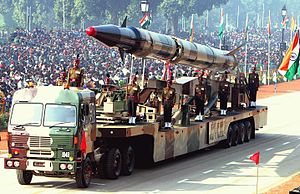India successfully test-fires Agni-III missile
Sunday, July 9, 2006
India's most sophisticated Intermediate Range Ballistic Missile (IRBM) to date, the Agni III was test-fired off the Orissa coast earlier today. The missile took off from a fixed platform at the Integrated Test Range at Wheeler Island at 11:05 IST (05:35 GMT) in the presence of Defence Minister Pranab Mukherjee and his scientific advisor M. Natarajan.

The missile took off vertically into space before re-entering the atmosphere and splashing down near Nicobar Island in the Bay of Bengal. Three sophisticated radars, six electro-optical tracking systems and three telemetric data stations on the mainland at Dhamra, Chandipur and the Andamans, together with a ship anchored near the splash-down point monitored the missile's trajectory. According to eyewitnesses, the missile blasted off into the sky leaving behind a trail of thick yellow smoke and disappeared out of sight into the clouds within seconds.
The Agni-III, which has a range of 3,500 km and can carry up to 1000 kg of payload, has been described as the most powerful missile developed by India's Defence Research and Development Organisation. The missile, which is 16 metres long and has a diametre of 1.8 metres, has solid fuel boosters and is capable of carrying both conventional and nuclear warheads. The Agni-I and Agni-II, which were the earlier versions of the Agni series developed under the Integrated Guided Missile Development Programme (IGMDP), have already been inducted into the Indian Army. Boosters for the earlier two missiles had been provided by the Indian Space Research Organisation, however, the Agni-III uses an entirely new booster vehicle.
Sources
- "Agni-III missile test-fired" — CNN-IBN, 9 July 2006
- "Agni III test-fired" — TimesNow, 9 July 2006
| This page has been automatically archived by a robot, and is no longer publicly editable.
Got a correction? Add the template {{editprotected}} to the talk page along with your corrections, and it will be brought to the attention of the administrators. Please note that the listed sources may no longer be available online. |